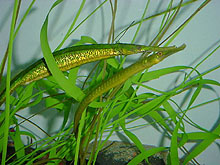| Home A B C D E F G H I J K L M N O P Q R S T U V W X Y Z |
|
Home |
What Is a Pipefish?Answer: 
Pipefishes or pipe-fishes (Syngnathinae) are a subfamily of small fishes, which, together with the seahorses, form the family Syngnathidae. Pipefish look like straight-bodied seahorses with tiny mouths. The name is derived from the peculiar form of their snout, which is like a long tube, ending in a narrow and small mouth which opens upwards and is toothless. The body and tail are long, thin, and snake-like. They have a highly modified skeleton formed into armored plating. This dermal skeleton has several longitudinal ridges, so that a vertical section through the body looks angular, not round or oval as in the majority of other fishes. A dorsal fin is always present, and is the principle (in some species, the only) organ of locomotion. The ventral fins are constantly absent, and the other fins may or may not be developed. The gill openings are extremely small and placed near the upper posterior angle of the gill cover. Many are very weak swimmers in open water, moving slowly by means of rapid movements of the dorsal fin. Some species of pipefish have tails that are prehensile, as in seahorses. The majority of pipefishes have some form of a caudal fin (unlike seahorses), which can be used for locomotion. There are species of pipefish with more developed caudal fins, such as the group collectively known as flagtail pipefish, which are quite strong swimmers. Most pipefish are marine dwellers; only a few are freshwater species. Pipefishes are abundant on coasts of the tropical and temperate zones. Most species of pipefish are usually 35–40 cm in length and generally inhabit sheltered areas in coral reefs, seagrass beds and sandy lagoons. There are approximately 200 species of pipefish. |
|
|
|
|
| References Resources Contact |